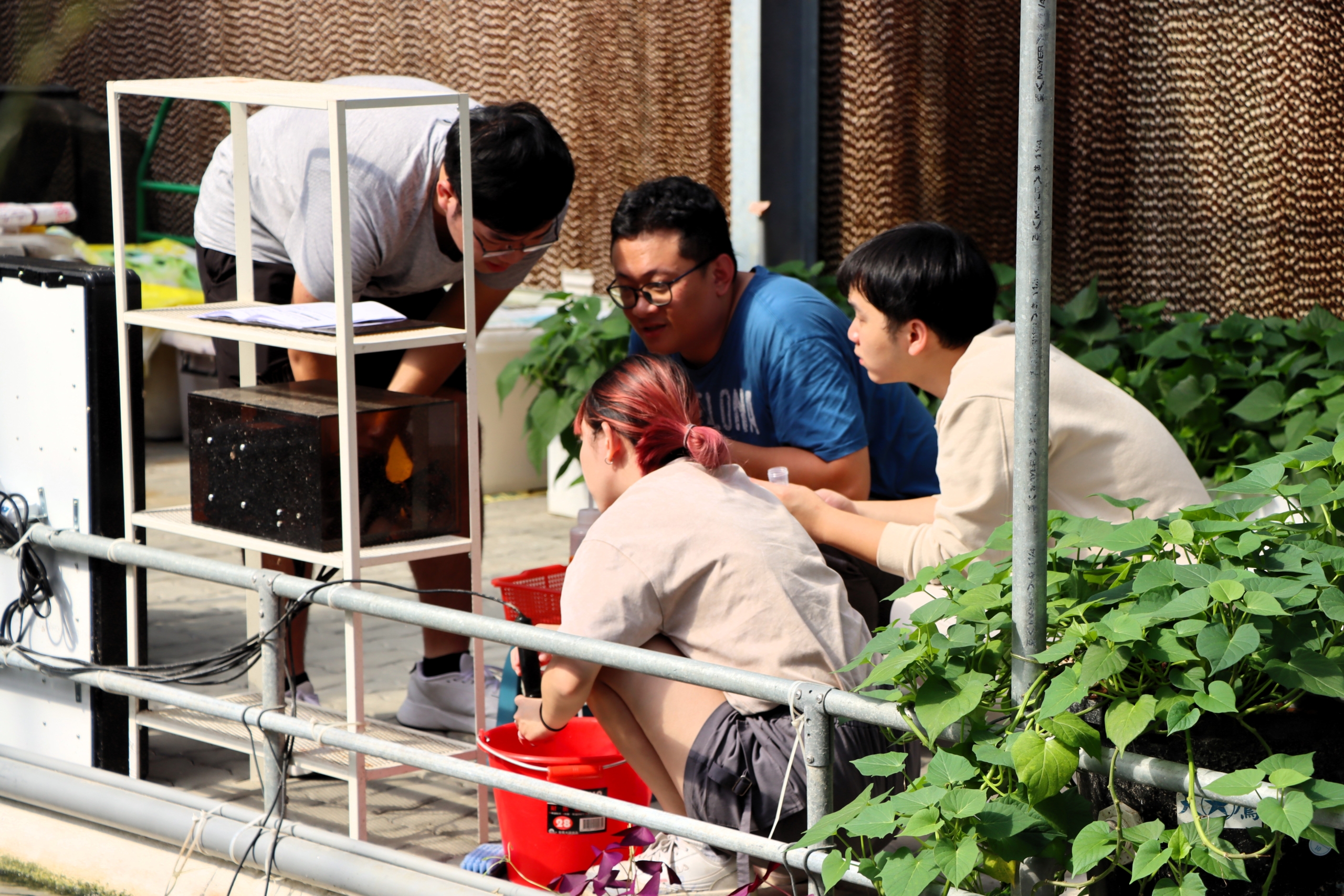Youyou Xiayun Fish-Vegetable Symbiosis Farm was founded by a couple, Mr. Huang and Ms. Chen, who are dedicated to the practice of aquaponics. Aquaponics is an innovative, sustainable agricultural model that integrates aquaculture and hydroponic farming. By creating an interactive ecosystem between fish tanks and plant beds, the system enables the cultivation of both fish and vegetables, achieving a mutually beneficial cycle.
Upon our arrival at the farm, Ms. Chen warmly greeted us and offered a delightful homemade fruit tea made from freshly picked flowers and fruits. The tea had a natural, fragrant taste that seemed to convey both the teachers’ warmth and their sincere hospitality. Afterward, Ms. Chen took us on a tour of the aquaponics facilities, explaining the various vegetables and fruits they grow. The crops looked exceptionally fresh and vibrant, a clear reflection of the care and dedication both Mr. Huang and Ms. Chen have toward the land. One key aspect of managing an aquaponics system is maintaining optimal “water quality.”
The core principle of aquaponics is that fish live in the water and release waste containing ammonia nitrogen. This ammonia is converted by microorganisms into nutrients—specifically nitrate nitrogen—that plants require for growth. Plant roots absorb these nutrients, promoting their development. Meanwhile, the plants’ roots also filter out harmful substances from the water, keeping it clean. As a result, maintaining and adjusting water quality is crucial. At the farm, we measured water quality indicators such as ammonia nitrogen, nitrate nitrogen, and pH levels. These parameters directly impact the health of both the fish and the plants, ensuring that the water remains within optimal ranges.
Although we encountered some difficulties during the measurement process, such as issues with the instrument settings, we were able to complete the task with the help of a senior student. The pH level needs to be kept between 6.5 and 7.5. Ammonia nitrogen levels that are too high can be toxic to the fish, so regular monitoring and adjustment are necessary. Nitrate nitrogen, on the other hand, is a vital nutrient for plant growth, and it must stay within an appropriate range—too much or too little will negatively affect plant health.
After gaining a better understanding of the aquaponics system, Ms. Chen invited us to help prepare lunch. We began by harvesting fresh lettuce from the vegetable beds, carefully cultivated by Ms. Chen. The lettuce, along with the bell peppers, was not only sweet and fresh but also radiated a natural, wholesome aroma. Next, Ms. Chen guided us through making pasta sauce and shared her recipe, which we paired with her homemade natural yogurt and mushroom soup. With everyone’s teamwork, we enjoyed a healthy, delicious meal made with fresh vegetables and wholesome, natural ingredients.
Following lunch, Mr. Huang led us in planting seedlings. Under his guidance, we planted strawberries and green beans, and then cleaned and transplanted lettuce seedlings into specially designed Styrofoam boards, with their roots submerged in the aquaponics water. This soil-free cultivation method allows the plants to grow by absorbing nutrients directly from the water. Through these hands-on activities, I gained a deeper understanding of how the aquaponics system functions—it’s not only an innovative agricultural technique but also a system that requires careful management and fine-tuning.
An aquaponics system typically consists of several key components: fish tanks, water pumps, plant beds, and inlet and outlet pipes. The fish tanks house the fish, and the water pump circulates water from the fish tanks to the plant beds, where vegetables are grown and the water is filtered. Each component is interconnected, and any oversight, from water quality monitoring to plant cultivation and fish farming, can affect the sustainability and efficiency of the entire system.
To end the day, Ms. Chen treated us to homemade natural ice cream, a sweet treat that provided the perfect conclusion to a day filled with learning and hands-on experiences. Through this visit and practical session, I gained a much deeper understanding of the principles, processes, and real-world applications of aquaponics. It was not just an insightful exploration of a cutting-edge agricultural system but also a joyful experience that highlighted the importance of nature, innovation, and collaboration. I sincerely thank Ms. Chen and Mr. Huang for their enthusiastic guidance, and I felt their deep connection to both the land and the aquaponics system.
Text by Li, Yun-Ting
Edited by Li, Ruo-Jia
Photos by Li, Ruo-Jia








